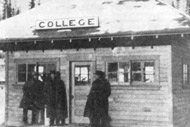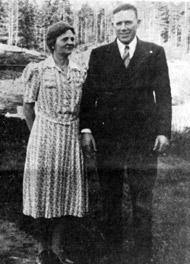Secretary recalls frontier college
Secretary recalls frontier college
A article from the Fairbanks Daily News-Miner that appeared April 30, 1984 summarizes one of the memoirs of LarVern Keys, the first secretary for the Alaska Agricultural College and School of Mines by Susan Fisher

She sold supplies, registered students, handled accounting, supervised the "shelf-less"
library, walked three miles to work, and, when she remembered, rang the bell to signal
the start of class.
LarVern Borell Keys, who turned 89 in February 1984, has written a short memoir of
her days as the first secretary to the first president of the Alaska Agricultural
College and School of Mines.

The very humble beginnings of the University of Alaska are chronicled elsewhere, such as William R. Cashen's book, "Farthest North College President," about first president Charles E. Bunnell. Keys bypasses "the serious and scholastic side" of history to write about the "thises and thats."
What days those were indeed. LarVern Borell, who graduated from the University of
Idaho in 1921, arrived in Fairbanks the following year to become secretary of the
new college.
Not in her memoirs is the story of how she came to get the job. The president of the
University of Idaho had recommended her to Bunnell, who tracked her down in Spokane,
where she was working. She had never met her would-be boss, or seen Alaska.
Bunnell had a budget of $41,000 that first year of the college. He expected to hire
six teachers, some doing double-duty, at an average salary of $3,400.
It was 1922. The streets weren't paved. Restaurant lunch prices were a staggering
$1.50 to $2, in an economy where gold pieces were in circulation and prices so high
that nickels and dimes weren't used. Registration fees for the first six students
at the college was $2 apiece, which LarVern Borell (Keys) deposited into a cigar box.
They were the good old days, in some pleasant respects, but this 23-page summary also
recounts some of the harsher facts of pioneer days in the subarctic.
Keys rented a 10-by-14 foot cabin on Front Street. "In one corner was the 'privy.'
It was quite different -- the usual board seat, but with a five-gallon gasoline can
below. At intervals, the garbage man lifted a lid on the outside and replaced the
can with another one.
As for water, a pail stood on the shelf in the kitchen. When I needed water, I put a bucket outside the back door and a sign in the front window. On one side of the sign was a '1,' on the other side was a '2,' indicating whether I wanted one or two pails of water. Of course when I got home in the evening, the water had been delivered but it was frozen."

It was five miles by unpaved road from the downtown to the new college. If she couldn't get a ride, Keys took the shortcut, walking three miles along the railroad tracks. But President Bunnell was not pleased that she couldn't be at work by 8 a.m. sharp.
"There was so much to be done, the president was soon talking about the need for me to live on campus, in order to work longer hours! Well, there was certainly a lot to be done—and just the two of us," she recounts. They frequently worked weekends. Teachers today would appreciate the teacher-student ratio of those early times—there were six faculty and six students then.

The president was anxious to get a mining short course started and soon we were registering
older men who came in from their claims anxious to take the course. The men enjoyed
the library, especially the newspapers which came in regularly from different parts
of the territory."
Bunnell lobbied the railroad to do something about transportation. Finally, a 14-foot-long,
enclosed rail car was located to make three trips a day between the college and downtown.
"The little car was loaded to the hilt with men hanging onto the straps in the aisle.
We had to tuck our feet well under us to save being trampled on as we jiggled and
jostled along over the bumpy track. With all the inconvenience and discomfort we were
grateful for the car—better than walking those three miles on the track as I had in
July and August," Keys writes. Soon thereafter the College Station depot opened.
With the mining short course in session, the next addition was the home economics
short course and that proved very popular with the women in Fairbanks. A large loom
was purchased and many lovely items were woven on it. As I sit here in my living room
now some 60 years later, I see and treasure a pillow top I made on that loom."
The very first year of the college, "Jack" Shanly graduated in agriculture, having completed three years at Cornell. Keys describes
the ceremony: "It was hot, and the caps and gowns didn't help. There were oodles of
mosquitoes. Need I say more! There was a door at the back of the stage and suddenly
through that door came lighted smudge pots. The janitor shoved them near our individual
chairs and the smoke curled ceilingward. It was anything but dignified but far more
comfortable."
Bunnell, adamant that the secretary should live closer to campus, built the cabin
himself. That was the start of faculty and student housing.
One hot day, while he was digging away, I received a call that an Austrian count was
on the way out from Fairbanks to see him. I hurried out to tell him," Keys says. Bunnell's
response was: "Tell him I am digging a basement! I would be pleased to have him come
out here!"
Keys, seeing the count was aghast at that, offered an explanation that Bunnell wanted
the exercise. "When we arrived at the excavation, the president wiped his brow, his
hands, and proceeded to engage in conversation as (though) there wasn't anything unusual
about the situation," she said.
"The president decided we should have a museum," Keys writes. A glass-topped display
cabinet was purchased from a bakery, and Bunnell placed a few artifacts from his private
collection in the cabinet. "The cabinet was not locked and strange things had a way
of appearing therein," said Keys, such as a student's missing suspenders.
Bunnell was president for 30 years. As the college organized and grew in the earlier
years, Keys writes that she and Bunnell frequently debated academic quality versus
enrollment.
"I was very much for upgrading scholarship. The President, although an excellent scholar
at Bucknell, was very much for numbers," she said. In 1931, LarVern and George Keys
gave a bronze plaque to the freshman girl with high accomplishments. "My hope was
that perhaps it would help girls to come forward more and accomplish more. I guess
I was sort of a suffragette without knowing it." The plaque continued for many years,
but Keys bemoans that somebody reduced the academic requirements, and that diminished
the honor in her view. LarVern had graduated second in her university class, and was
named a Phi Beta Kappa by special decree.
LarVern married George Keys in 1925. They celebrated their 59th anniversary this year.
She recounts how her husband-to-be one day burst into the office. He had found a box
of dynamite under a stairway. "Hard to tell how long the box had been there—at least
10 or 12 years." George Keys disposed of it using a long pole to ignite it. "The box
exploded and burned vigorously."
"The President (Bunnell) has a habit of taking off for Washington D.C. during the
winter. He usually went during November and would be gone five or six weeks. During
his absence, everything went through my office; even in later years when a dean had
been appointed. How I dreaded to have him go! Seems like something was always happening."
Bunnell was not pleased with LarVern's marriage to George Keys. She attributes his
grumbling as one of his quirks. "If anyone of the staff married, he grumbled."
"We were met at College Station by a group of students banging on dish pans and what
have you. They carried our bags to our temporary quarters in the college building.
The next morning the student body came down and chivalried us. Some cut a beginner's
law class taught by the president! He was so angry he locked the classroom door and
gave them all zero for cutting class."
Despite those quirks—and political differences (Bunnell was a Democrat, Keys a Republican)
—she praises Bunnell, who began his workday whistling and having a cigar.
"I believed then—and I believe now—some 60-odd years later—that the present University
of Alaska owes a very great deal of its present status of accomplishment to the foresight,
statesmanship, energy, ability, and constant upgrading management of its first president—Dr.
Charles E. Bunnell," Keys concludes.
Keyses stay in touch with UA friends
Over the years Earl Beistline has coaxed LarVern Keys to write down her memories of the University of Alaska's early beginnings, and many of those pages are now in the university archives.
After their marriage, LarVern continued as the college secretary, and Keys ran the
new physical plant. They had an apartment over the new plant.
The two left Alaska in 1935 to buy a farm in Orcas Island in Washington.
LarVern met George when he arrived to take the mining short course at the new college.
George Keys and his father and brothers had been mining in Alaska, and after serving
in France during World War I, he returned here and worked a coal miner.
LarVern Keys' last visit to Fairbanks was in 1977.
